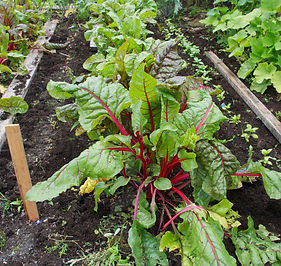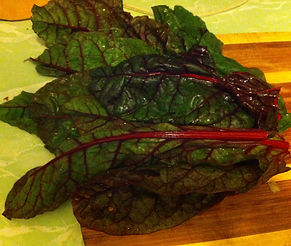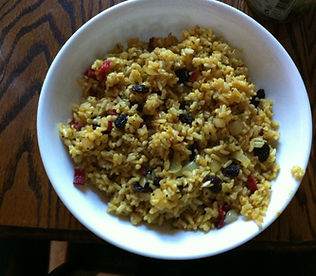
Grow Your Own Healthy Meals
Chard

Rhubarb Chard

Ready to Go

Chard stems & raisins in curried rice
First of All
We pronounce chard as "chard", not "shard". In our view, no matter how lovely and clear-headed you may be, if you say "Swiss Shard", you sound drunk. But anyway, as Shakespeare shaid, "shard by any other name would tashte as shweet."
Varieties We Grow
Shhard is colourful shtuff, with shtems in shadesh of red, pink, orange and yellow. We grow red-shtemmed Rhubarb shard (60 daysh till firsht harvesht); yellow/orange/crimshon/purple-shtemmed Bright Lightsh (60 daysh); and white-shtemmed, light- green-leafed Lucullush (50 days). Lucullush ish a little more tolerant of heat than the firsht two varietiesh; but even if you have a really hot shpell, jusht keep the plantsh' rootsh sufficiently watered (around a cup a day at the bashe of the plant). They'll keep producing delicious leavesh & stalksh. And yesh, the stalksh are edible, too. (I'll shtop now.)
Slugs and snails like to chomp on chard, so we suggest you go on frequent 'search & destroy' missions. (see Slugs for pointers). But aside from the often relentless attack missions by slugs, Swiss Chard is pretty low-maintenance for us organic gardeners.
If the seeds are planted in compost-rich soil in a sunny location and if the seedlings and mature plants get the necessary amount of regular watering, they'll produce delicious leaves throughout the late spring, summer, fall and even into the winter.
Getting Started
You can sow chard seeds as early as the soil can be worked, around three weeks before your last frost date. Sow the seeds ½ inch deep, about 2 inches apart. As the seedlings grow, thin them to about 8 inches apart. Water & weed and go on slug patrol regularly. Cover the tender seedlings with a floating row cover to protect them from insect pests.
Care & Harvesting
Side dress your chard with compost one or two times during the growing season and keep the plants free of weeds. Don't let the chard leaves get too big before you harvest them. When the leaves get to 8 inches or so in length, they can be picked. These younger leaves are more tender & flavourful.
Harvest the outside bottom leaves first and don't take too many off one plant at once. We use scissors or a sharp knife to slice off the leaves near the base of the stem because pulling and twisting the leaves off sometimes uproots the plant.
Chard can stand a few frosts, and if you mulch and protect the plants with a cloche, you can have fresh chard in the dead of winter.
Chard is a good for you, too. It's a source of vitamins A & C and of calcium, so eat your fill of fresh leaves in salads, steamed, stir-fried with chopped garlic, olive oil & sea salt and as a green layer in vegetarian lasagna.
Companion Plants for Swiss Chard
Chard does well near onions and brassicae (cabbage family) plants. You can plant thyme among these veggies to deter insect pests and nasturtiums to attract aphids away from them.